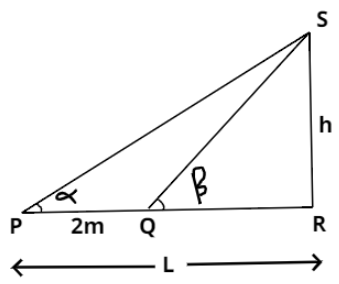Question
Question: The angle of elevation of the top of a vertical tower from a point P on the horizontal ground was ob...
The angle of elevation of the top of a vertical tower from a point P on the horizontal ground was observed to be α. After moving a distance of 2 meters from P towards the foot of the tower, the angle of elevation changes to β. Then the height (in meters) of the tower is:
(A) sinαsinβcos(β−α) (B) sinαsinβ2sin(β−α) (C) sin(β−α)2sinαsinβ (D) cos(β−α)sinαsinβ
Solution
Hint: Analyze the situation with a diagram. Use trigonometric ratios to find the distance of point P from the foot of the tower in both cases. And then compare both values to get the desired result.
Complete step-by-step answer:

Consider the above figure, let L be the initial distance of the foot of the tower from point P and h be the height of the tower.
As per the information given in the question, α is the angle of elevation of the top of the tower from point P.
From ΔPRS shown above:
⇒tanα=PRSR ⇒tanα=Lh ⇒L=tanαh.....(i)
Now, after moving 2 meters towards the tower we reach another point Q. Then the distance between the foot of the tower and point Q is L−2. And the angle of elevation of the top of the tower from point Q is given in the question as β. So in ΔQSR in the above figure:
⇒tanβ=QRSR ⇒tanβ=L−2h, ⇒L−2=tanβh, ⇒L=tanβh+2.....(ii)
Now, comparing equation (i) and (ii), we have:
⇒tanαh=tanβh+2, ⇒h(tanα1−tanβ1)=2,
Taking tanαtanβ as LCM, we’ll get:
⇒h(tanαtanβtanα−tanβ)=2, ⇒h=tanα−tanβ2tanαtanβ
Now we know that, tanθ=cosθsinθ, applying this we’ll get:
We know that, sinAcosB−cosAsinB=sin(A−B), applying this formula, we’ll get:
⇒h=sin(α−β)2sinαsinβ
Therefore, the height of the tower is sin(α−β)2sinαsinβ. Option (C) is correct.
Note: We can use any of the trigonometric ratios to get the end results. But in this case, perpendicular and base are known for the given angles so it is convenient to use either tanθ or cotθ. If we want to use any other trigonometric ratios, then we have to determine hypotenuse first by using Pythagoras theorem.
